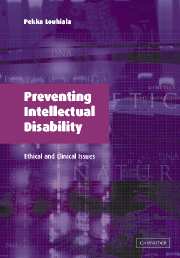Book contents
- Frontmatter
- Contents
- Acknowledgements
- 1 Introduction
- 2 On the definition of intellectual disability?
- 3 Epidemiology of intellectual disability
- 4 Prevention of intellectual disability: general issues
- 5 Prenatal diagnosis and screening
- 6 Genetic counselling
- 7 Why should intellectual disability be prevented?
- 8 Moral status and intellectual disability
- 9 The ethics of prevention in practice: three syndromes
- 10 Conclusion
- References
- Index
9 - The ethics of prevention in practice: three syndromes
Published online by Cambridge University Press: 09 August 2009
- Frontmatter
- Contents
- Acknowledgements
- 1 Introduction
- 2 On the definition of intellectual disability?
- 3 Epidemiology of intellectual disability
- 4 Prevention of intellectual disability: general issues
- 5 Prenatal diagnosis and screening
- 6 Genetic counselling
- 7 Why should intellectual disability be prevented?
- 8 Moral status and intellectual disability
- 9 The ethics of prevention in practice: three syndromes
- 10 Conclusion
- References
- Index
Summary
Down syndrome
Down syndrome (DS) was first described as a separate entity in 1866 in an article titled ‘Some observations on an ethnic classification of idiots’ by British physician John Langdon Down (Booth 1985). He had observed that a large number of congenital idiots resembled Mongols and therefore he described them as Mongolian idiots.
Although the syndrome has carried Dr Down's name ever since, he was not, however, the first to associate intellectual disability and Mongolian racial characteristics. Already in 1844 Robert Chambers had suggested a theory of degeneration, according to which the human brain goes through various stages of development from animal forms to ‘Negro, Malay, American, and Mongolian nations and finally is Caucasian’ (Chambers R. The Vestiges of the Natural History of Creation (1844), cited by Booth 1985, p. 4). Chambers suggested that ‘parents too nearly related tend to produce offspring of the Mongolian type – that is, persons who in maturity still are a kind of children’ (Booth 1985).
The ‘official’ history of DS is thus a little more than 150 years old. It is not clear whether the syndrome had been recognised earlier, since histories of childbirth and midwifery omitted children born with physical impairments (Booth 1985). Almost certainly the syndrome existed, however, long before its recognition.
John Langdon Down not only described the physical characteristics of this group of people, but also drew attention to the features of their personality:
They have considerable powers of imitation, even bordering on being mimics. They are humorous, and a lively sense of the ridiculous often colours their mimicry.[…]
- Type
- Chapter
- Information
- Preventing Intellectual DisabilityEthical and Clinical Issues, pp. 136 - 152Publisher: Cambridge University PressPrint publication year: 2003



